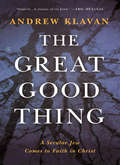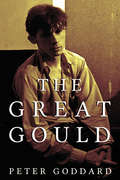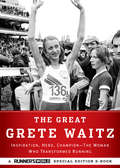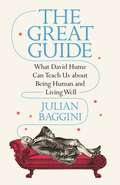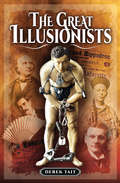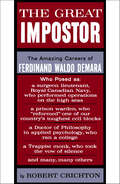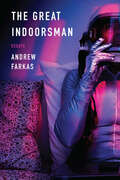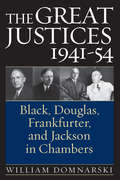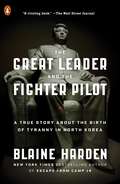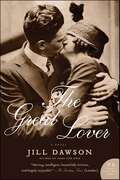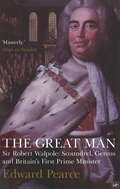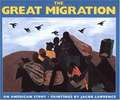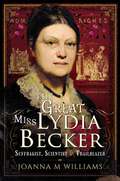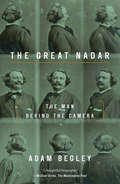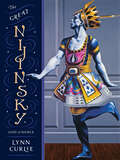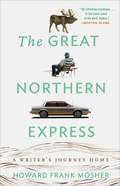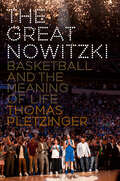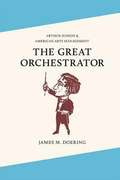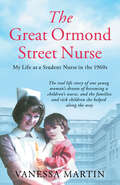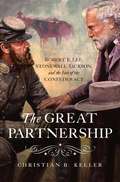- Table View
- List View
The Great Good Thing
by Andrew KlavanEdgar Award-winner and internationally bestselling novelist tells of his improbable conversion from agnostic Jewish-intellectual to baptized Christian and of the books that led him there.“Had I stumbled on the hallelujah truth, or just gone mad—or, that is, had I gone mad again?”No one was more surprised than Andrew Klavan when, at the age of fifty, he found himself about to be baptized. <P><P> Best known for his hard-boiled, white-knuckle thrillers and for the movies made from them—among them True Crime (directed by Clint Eastwood) and Don’t Say a Word (starring Michael Douglas)—Klavan was born in a suburban Jewish enclave outside New York City. He left the faith of his childhood behind to live most of his life as an agnostic in the secular, sophisticated atmosphere of New York, London, and Los Angeles. But his lifelong quest for truth—in his life and in his work—was leading him to a place he never expected. <P><P> In The Great Good Thing, Klavan tells how his troubled childhood caused him to live inside the stories in his head and grow up to become an alienated young writer whose disconnection and rage devolved into depression and suicidal breakdown. But he also stumbled into a genuine romance, a passionate and committed marriage whose uncommon and enduring devotion convinced him of the reality of love.In those years, Klavan fought to ignore the insistent call of God, a call glimpsed in a childhood Christmas at the home of a beloved babysitter, in a transcendent moment at his daughter’s birth, and in a snippet of a baseball game broadcast that moved him from the brink of suicide. But more than anything, the call of God existed in stories—the stories Klavan loved to read and the stories he loved to write. <P><P> The Great Good Thing is the dramatic, soul-searching story of a man born into an age of disbelief who had to abandon everything he thought he knew in order to find his way to the truth.
The Great Gould
by Peter GoddardA startling new portrait of Gould, including never-before-seen material. Glenn Gould’s astonishing recordings deliver that unmistakable jolt of genius to each generation newly discovering the great Canadian pianist. With the support of the Glenn Gould Estate, Peter Goddard draws on his own interviews with Gould and on new, and in some cases overlooked, sources to present a freshly revealing portrait of Gould’s unsettled life, his radical decision to quit concertizing, his career as a radio innovator, and his deep response to the Canadian environment. Sci-fi and hi-fi, hockey and Petula Clark, Elvis, jazz, chess, the Beatles, and sex — all these inform this exploration of the pianist’s far-reaching imagination. There is even a touching account of the only piano lesson Gould ever gave. This is the perfect gift for anyone new to classical music and those already immersed in it, for those with an interest in Canadian music, in Glenn Gould himself, and in what led to The Goldberg Variations, one of the greatest recordings in music history.
The Great Grete Waitz: Inspiration, Hero, Champion: The Woman Who Transformed Running (Runner's World)
by Editors of Runner's WorldIn The Great Grete Waitz, Runner's World has published a moving tribute to the humble marathon legend who changed the landscape of running forever. The editors of the magazine have gathered a collection of the best stories about Grete from the last 30 years, providing a revealing glimpse into the "quiet queen" who won the New York City Marathon an astounding nine times, helping to turn the event into a worldwide phenomenon. The Great Grete Waitz is an unforgettable, across-the-decades portrait of a truly pioneering spirit who changed the sport of running forever.
The Great Guide: What David Hume Can Teach Us about Being Human and Living Well
by Julian BagginiInvaluable wisdom on living a good life from one of the Enlightenment's greatest philosophersDavid Hume (1711–1776) is perhaps best known for his ideas about cause and effect and his criticisms of religion, but he is rarely thought of as a philosopher with practical wisdom to offer. Yet Hume's philosophy is grounded in an honest assessment of nature—human nature in particular. The Great Guide is an engaging and eye-opening account of how Hume's thought should serve as the basis for a complete approach to life.In this enthralling book, Julian Baggini masterfully interweaves biography with intellectual history and philosophy to give us a complete vision of Hume's guide to life. He follows Hume on his life's journey, literally walking in the great philosopher's footsteps as Baggini takes readers to the places that inspired Hume the most, from his family estate near the Scottish border to Paris, where, as an older man, he was warmly embraced by French society. Baggini shows how Hume put his philosophy into practice in a life that blended reason and passion, study and leisure, and relaxation and enjoyment.The Great Guide includes 145 Humean maxims for living well, on topics ranging from the meaning of success and the value of travel to friendship, facing death, identity, and the importance of leisure. This book shows how life is far richer with Hume as your guide.
The Great Harry Houdini (Fountas & Pinnell Classroom, Guided Reading Grade 5)
by Claire GoldingImpossible! He let people handcuff him and dump him in deep water. He was tied and hung upside down one hundred feet (thirty meters) above the ground. He risked injury or death nearly every day for forty years. Why in the world did he do it? NIMAC-sourced textbook
The Great Houdini: World Famous Magician & Escape Artist (Step into Reading)
by Monica Kulling Anne ReasHarry Houdini was a great escape artist, but perhaps his greatest trick was becoming the famous magician that we have come to know. As a child, Houdini worked hard--and even quit school--to help support his family. But his dream always was to become a great magician and performer. He practiced day and night, thinking up new tricks and more and more dangerous stunts. His intense ambition paid off, and soon Harry Houdini became known worldwide! This kid-appealing Step 3 traces Houdini's life from his poor beginnings to his eventual success as the most famous mystical magician and escape artist of all time.
The Great Illusionists
by Derek TaitHoudini and beyond: a historic magical mystery tour of the great showmen who inspired the likes of David Blaine, Penn & Teller, and Siegfried & Roy. Today, Harry Houdini stands as the most famous illusionist and escape artist in history. But from the late nineteenth century to early twentieth century, magicians and escapologists who inspired—and were inspired by—Houdini packed vaudeville houses and local theaters across the globe. The Great Illusionists reveals the careers, lives, and sometimes shocking on-stage deaths of the greatest showmen to ever wow the world. In addition to the astounding accomplishments of Houdini, marvel at the feats of Jean-Eugène Robert-Houdin, the “Father of Modern Conjuring”; the Davenport Brothers, music hall mediums and devotees of the Spiritualist movement; the “Dean of American Magicians” Harry Kellar; master illusionists, the Great Raymond, David Devant, the Great Lafayette, and Chung Ling Soo; the novelty performances of The Human Fly and Datas, “The Living Encyclopedia”; and many more. From vanishing acts and public seances to harrowing bullet-tricks and psychic wizardry, The Great Illusionists brings to life a unique history of entertainment.
The Great Impostor: The Amazing Careers of Ferdinand Waldo Demara
by Robert CrichtonIn this forthright account of a remarkable fraud inFerdinand Waldo Demara, Robert Crichton presents the man, his reasons, and his methods. A New York Times bestseller when it was originally published in 1959, and serving as the inspiration for the Tony Curtis film of the same name, this is the fascinating and disturbing story of America’s Great Impostor.The fantastic lives and careers of Ferdinand Waldo Demara make a fantastic irony of the platitude that truth is stranger than fiction. For with Ferdinand Demara, truth is fiction.Demara wanted to be a hero, to lead an epic life dedicated to the benefit of others, and to gain adulation for himself, and he did all those things by lying to others about who he was. During his storied career, Ferdinand Demara managed to “become” a Trappist monk; a doctor of psychology and Dean of the School of Philosophy at a small college in Pennsylvania; a law student, zoology graduate, cancer researcher and teacher at a junior college in Maine; a surgeon-lieutenant in the Royal Canadian Navy (as medical officer on the destroyed Cayuga, he successfully performed major surgery); a brilliant assistant warden of a Texas prison; and a teacher and beloved idol of the children on a Maine island village.
The Great Indoorsman: Essays
by Andrew FarkasMany authors have traveled and explored the out-of-doors, both in life and then in their books, proving themselves stalwart, audacious, even heroic; Andrew Farkas is not among them. He is brave enough to admit that the outdoors isn&’t for him. Instead, in these essays Farkas reports on his bold explorations of a very different territory: the in-of-doors, the waiting rooms, kitchens, malls, bars, theaters, roadside motel rooms, and other places that feature temperature control, protection from rampaging predators, and a higher degree of comfort than can be found outside. Farkas discovers that, just as the mannered and wonderfully (gloriously) artificial indoors influences us greatly, our lives are also controlled much more by fiction than by anything &“real.&” So come in out of the weather (it&’s always terrible) and join the Great Indoorsman on his adventures, where he makes fun of pretty much everything, most of all himself.
The Great Jazz Artists
by James Lincoln Collier Robert Andrew ParkerSurveys the lives and music of such well-known jazz performers as Jelly Roll Morton, Louis Armstrong, Billie Holiday, Charlie Parker, and others.
The Great Justices 1941-54
by William DomnarskiDomnarski is a practicing intellectual property attorney in California and the author of a previous book on the history and nature of federal court judicial opinions. In this text, the author compares four brilliant and diverse jurists of the Roosevelt-era Court--Hugo Black, William O. Douglas, Felix Frankfurter, and Robert Jackson--during the period from 1941 to 1954. The study explores the Court's evolving civil rights jurisprudence that was born in the period during which the four justices served together, considers the Court as an institution and its relation to the American public, and analyzes how four individual justices sharing core jurisprudential beliefs and ambitions before appointment would later divide into competing liberal and conservative factions. Annotation ©2006 Book News, Inc. , Portland, OR (booknews. com)
The Great Leader and the Fighter Pilot
by Blaine HardenFrom the New York Times bestselling author of Escape From Camp 14, Blaine Harden tells the riveting story of Kim Il Sung's rise to power, and the brave North Korean fighter pilot who escaped the prison state and delivered the first MiG-15 into American handsIn The Great Leader and the Fighter Pilot, New York Times bestselling author Blaine Harden tells the riveting story of how Kim Il Sung grabbed power and plunged his country into war against the United States while the youngest fighter pilot in his air force was playing a high-risk game of deception--and escape.As Kim ascended from Soviet puppet to godlike ruler, No Kum Sok noisily pretended to love his Great Leader. That is, until he swiped a Soviet MiG-15 and delivered it to the Americans, not knowing they were offering a $100,000 bounty for the warplane (the equivalent of nearly one milliondollars today). The theft--just weeks after the Korean War ended in July 1953--electrified the world and incited Kim's bloody vengeance.During the Korean War the United States brutally carpet bombed the North, killing hundreds of thousands of civilians and giving the Kim dynasty, as Harden reveals, the fact-based narrative it would use to this day to sell paranoia and hatred of Americans.Drawing on documents from Chinese and Russian archives about the role of Mao and Stalin in Kim's shadowy rise, as well as from neverbefore- released U.S. intelligence and interrogation files, Harden gives us a heart-pounding escape adventure and an entirely new way to understand the world's longest-lasting totalitarian state.From the Hardcover edition.
The Great Leader and the Fighter Pilot: The True Story of the Tyrant Who Created North Korea and the Young Lieutenant Who Stole His Way to Freedom
by Blaine HardenFrom the New York Times bestselling author of Escape From Camp 14, Blaine Harden tells the riveting story of Kim Il Sung's rise to power, and the brave North Korean fighter pilot who escaped the prison state and delivered the first MiG-15 into American handsIn The Great Leader and the Fighter Pilot, New York Times bestselling author Blaine Harden tells the riveting story of how Kim Il Sung grabbed power and plunged his country into war against the United States while the youngest fighter pilot in his air force was playing a high-risk game of deception--and escape.As Kim ascended from Soviet puppet to godlike ruler, No Kum Sok noisily pretended to love his Great Leader. That is, until he swiped a Soviet MiG-15 and delivered it to the Americans, not knowing they were offering a $100,000 bounty for the warplane (the equivalent of nearly one million dollars today). The theft--just weeks after the Korean War ended in July 1953--electrified the world and incited Kim's bloody vengeance.During the Korean War the United States brutally carpet bombed the North, killing hundreds of thousands of civilians and giving the Kim dynasty, as Harden reveals, the fact-based narrative it would use to this day to sell paranoia and hatred of Americans.Drawing on documents from Chinese and Russian archives about the role of Mao and Stalin in Kim's shadowy rise, as well as from never-before-released U.S. intelligence and interrogation files, Harden gives us a heart-pounding escape adventure and an entirely new way to understand the world's longest-lasting totalitarian state.From the Hardcover edition.
The Great Lover: A Novel
by Jill Dawson“A brilliant, complicated man is the centre of Jill Dawson’s The Great Lover, and while she draws extensively on historical records of Brooke and his contemporaries, it is her decisions as a novelist that make this account of his life fascinating as well as faithful. . . . . The story that emerges is strong, satisfying, and memorable.” — The Times (London)An imaginative, fascinating novel about one of the most enduringly popular and romantic figures of the First World War—the radical, handsome young poet Rupert Brooke.
The Great Man: Sir Robert Walpole: Scoundrel, Genius and Britain's First Prime Minister
by Edward PearceThe year 1721 has many splendours: great houses built by William Kent, fine pictures and the fruits of commerce. But there are also thirteen public hanging days a year, drunkenness is endemic, organised crime rampages through the streets. And politics are ferocious. Only a generation earlier, The Pretender failed to take the Crown; the new King is cursed as a damned foreigner; James's followers - the Jacobites - conspire and are persecuted; the South Sea Bubble collapses.Robert Walpole, once imprisoned for financial chicanery, assumes political control and becomes 'Prime Minister'. He personally detects a Jacobite plot, is dismissed in 1727 on the death of George I, recruits the new King's clever wife, Caroline, and bounces cheerfully back. Coarse, corrupt and cynical, Walpole dominates King, Parliament and Government until 1742. This is Mr Worldywiseman, keeping England out of war for twenty years and setting up a stable and growing economy. All politics of a kind we can recognise today begin with Robert Walpole. And here, in Edward Pearce's elegant book, he is brought vividly back to life.
The Great Migration: An American Story
by Jacob LawrenceA series of paintings chronicles the journey of African Americans who, like the artist's family, left the rural South in the early twentieth century to find a better life in the industrial North.
The Great Miss Lydia Becker: Suffragist, Scientist & Trailblazer
by Joanna M. WilliamsFifty years before women were enfranchised, a legal loophole allowed a thousand women to vote in the general election of 1868. This surprising event occurred due to the feisty and single-minded dedication of Lydia Becker, the acknowledged, though unofficial, leader of the women's suffrage movement in the later 19th century. Brought up in a middle-class family as the eldest of fifteen children, she broke away from convention, remaining single and entering the sphere of men by engaging in politics. Although it was considered immoral for a woman to speak in public, Lydia addressed innumerable audiences, not only on women's votes, but also on the position of wives, female education and rights at work. She battled grittily to gain academic education for poor girls, and kept countless supporters all over Britain and beyond abreast of the many campaigns for women's rights through her publication, the Women's Suffrage Journal. Steamrollering her way to Parliament as chief lobbyist for women, she influenced MPs in a way that no woman, and few men, had done before. In the 1860s the idea of women's suffrage was compared in the Commons to persuading dogs to dance; it was dismissed as ridiculous and unnatural. By the time of Lydia's death in 1890 there was an acceptance that the enfranchisement of women would soon happen. The torch was picked up by a woman she had inspired as a teenager, Emmeline Pankhurst, and Lydia's younger colleague on the London committee, Millicent Fawcett. And the rest is history.
The Great Nadar: The Man Behind the Camera
by Adam BegleyA dazzling, stylish biography of a fabled Parisian photographer, adventurer, and pioneer.A recent French biography begins, Who doesn't know Nadar? In France, that's a rhetorical question. Of all of the legendary figures who thrived in mid-19th-century Paris—a cohort that includes Victor Hugo, Baudelaire, Gustave Courbet, and Alexandre Dumas—Nadar was perhaps the most innovative, the most restless, the most modern.The first great portrait photographer, a pioneering balloonist, the first person to take an aerial photograph, and the prime mover behind the first airmail service, Nadar was one of the original celebrity artist-entrepreneurs. A kind of 19th-century Andy Warhol, he knew everyone worth knowing and photographed them all, conferring on posterity psychologically compelling portraits of Manet, Sarah Bernhardt, Delacroix, Daumier and countless others—a priceless panorama of Parisian celebrity. Born Gaspard-Félix Tournachon, he adopted the pseudonym Nadar as a young bohemian, when he was a budding writer and cartoonist. Later he affixed the name Nadar to the façade of his opulent photographic studio in giant script, the illuminated letters ten feet tall, the whole sign fifty feet long, a garish red beacon on the boulevard. Nadar became known to all of Europe and even across the Atlantic when he launched "The Giant," a gas balloon the size of a twelve-story building, the largest of its time. With his daring exploits aboard his humongous balloon (including a catastrophic crash that made headlines around the world), he gave his friend Jules Verne the model for one of his most dynamic heroes. The Great Nadar is a brilliant, lavishly illustrated biography of a larger-than-life figure, a visionary whose outsized talent and canny self-promotion put him way ahead of his time.
The Great Nijinsky: God of Dance
by Lynn CurleeA tragic story of a cultural icon—dance prodigy, sex symbol, LGBTQ+ pioneer—this compelling work of narrative nonfiction chronicles a life of obsessive artistry and celebrity of Vaslav Nijinsky. With one grand leap off the stage at the 1909 premiere of the Ballets Russes's inaugural season, Nijinsky became an overnight sensation and the century's first superstar, in the days before moving pictures brought popular culture to the masses. Perhaps the greatest dancer of the twentieth century, Nijinsky captured audiences with his sheer animal magnetism and incredible skill. He was also half of the most famous (and openly gay) couple of the Edwardian era: his relationship with Serge Diaghilev, artistic director and architect of the Ballets Russes, pushed boundaries in a time when homosexuality and bisexuality were rarely discussed. Nijinsky's life was tumultuous--after marrying a female groupie he hardly knew, he was kicked out of the Ballets Russes and placed under house arrest during World War I. Unable to work as he once did, his mental health deteriorated, and he spent three decades in and out of institutions.Biographical narrative is interspersed with spotlights on the ballets the dancer popularized: classic masterworks such as Afternoon of a Faun, The Firebird, and of course, the shockingly original Rite of Spring, which caused the audience to riot at its premiere. Illustrated with elegant, intimate portraits as well as archival art and photographs.
The Great Northern Express: A Writer's Journey Home
by Howard Frank MosherFrom bestselling, nationally celebrated author Howard Frank Mosher, a wildly funny and deeply personal account of his three-month, 20,000-mile sojourn to discover what he loved enough to live for. Several months before novelist Howard Frank Mosher turned sixty-five, he learned that he had prostate cancer. Following forty-six intensive radiation treatments, Mosher set out alone in his twenty-year-old Chevy Celebrity on a monumental road trip and book tour across twenty-first-century America. From a chance meeting with an angry moose in northern New England to late-night walks on the wildest sides of America's largest cities, The Great Northern Express chronicles Mosher's escapades with an astonishing array of erudite bibliophiles, homeless hitchhikers, country crooners and strippers, and aspiring writers of all circumstances. Full of high and low comedy and rollicking adventures, this is part travel memoir, part autobiography, and pure, anarchic fun. From coast to coast and border to border, this unforgettable adventure of a top-notch American writer demonstrates that, sometimes, in order to know who we truly are, we must turn the wheel towards home.
The Great Nowitzki: Basketball and the Meaning of Life
by Thomas PletzingerA journey into the mindset of a historic basketball superstar, and the importance of his landmark career. The seven-foot Dirk Nowitzki is one of the greatest players in basketball history. The Dallas Maverick’s legend revolutionized the sport, redefining the role of the big man in the modern game. Dirk moved differently: flexible and fast, confident and in control. He thought differently, too. On the court, his shots were masterful—none more venerated than his signature one-legged flamingo fadeaway, a move that lives on in the repertoire of today’s most skilled NBA players. How did this lanky kid from the German suburbs become an all-time top ten scorer and NBA champion? How can a superstar stay so humble? Award-winning novelist and sportswriter Thomas Pletzinger spent over seven years traveling with Nowitzki. He witnessed Dirk’s summer workouts, involving fingertip pushups and the study of the physics, and spent days discussing literature and philosophy with Holger Geschwindner, Dirk’s enigmatic mentor and coach. Watching Nowitzki in empty gyms and in packed arenas with 30,000 fans, Pletzinger began to understand how Dirk and Holger’s philosophical insights on performance, creativity, and freedom enabled his success and longevity. The Great Nowitzki tells Dirk’s dramatic story like never before. Pletzinger describes Dirk’s youth in small-town Germany, follows the steep learning curve of Dirk’s early seasons, the devastating Finals loss to the Miami Heat, and the triumphant championship five years later. Traveling with Dirk in his final seasons, Pletzinger immerses himself in the community of people impacted by Nowitzki’s game, interviewing everyone from average fans in Dallas and security guards at the arena to front office executives and Hall of Fame teammates, who reflect on what Dirk’s career means to the next generation of ballplayers. And to the game itself. A masterpiece of sports writing that reads like a novel, The Great Nowitzki brims with a fan’s passion. Pletzinger shows how strongly basketball influences our imagination and the extraordinary journey an icon like Dirk Nowitzki must take to reach the pinnacle of the game.
The Great Orchestrator: Arthur Judson and American Arts Management (Music in American Life)
by James M. DoeringThis biography charts the career and legacy of the pioneering American music manager Arthur Judson (1881-1975), who rose to prominence in Philadelphia and New York at the beginning of the twentieth century. A violinist by training, Judson became manager of the Philadelphia Orchestra in 1915 under the iconic conductor Leopold Stokowski. Within a few years, Judson also took on management of the New York Philharmonic, navigating a period of change and the tenures of several important conductors who included William Mengelberg, Arturo Toscanini, and John Barbirolli. Judson also began managing individual artists, including pianists Alfred Cortot and Vladimir Horowitz, violinist Jasha Heifetz, and cellist Gregor Piatigorsky. He also organized the U.S. tours of several prominent composers, including Igor Stravinsky and Vincent d'Indy. At the same time, Judson began managing conductors. His first clients were Stokowski and Fritz Reiner. By the 1930s, Judson's conductor list included most of the important conductors working in America. Drawing on rich correspondence between Judson and the conductors and artists he served, James M. Doering demonstrates Judson's multifaceted roles, including involvement with programming choices, building audiences, negotiating with orchestra members and their unions, and exploring new technologies for extending the orchestras' reach. In addition to his colorful career behind the scenes at two preeminent American orchestras, Judson was important for a number of innovations in arts management. In 1922, he founded a nationwide network of local managers and later became involved in the relatively unexplored medium of radio, working first with WEAF in New York City and then later forming his own national radio network in 1927. Providing valuable insight into the workings of these orchestras and the formative years of arts management, The Great Orchestrator is a valuable portrait of one of the most powerful managers in American musical history.
The Great Ormond Street Hospital Nurse: My Life As A Student Nurse In The 1960s
by Vanessa Martin“You must learn to hold in your feelings,” Matron said, firmly but not unkindly. “One day it will be your duty to support the family and other staff through this tragedy. You need to be strong.” From the first time Vanessa Martin sets foot inside the world’s most renowned children’s hospital, she knows that she will never have another dull moment. From her first confrontation with the legendary matron, to consoling hordes of worried parents and caring for the wonderful bundles of joy themselves, Vanessa enters a world full of laughter, heartache and, most importantly, hard work. In this heartwarming memoir of a passionate, determined young woman trying to help as many children as she can, Vanessa pulls back the curtain on the bustling world of 60s London, and tells the remarkable story of finding her place within it. Nostalgic, charming and full of heart, The Great Ormond Street Nurse is the heroic tale of a woman who has dedicated over 40 years to the NHS.
The Great Ormond Street Hospital Nurse: My Life As A Student Nurse In The 1960s
by Vanessa Martin“You must learn to hold in your feelings,” Matron said, firmly but not unkindly. “One day it will be your duty to support the family and other staff through this tragedy. You need to be strong.” From the first time Vanessa Martin sets foot inside the world’s most renowned children’s hospital, she knows that she will never have another dull moment. From her first confrontation with the legendary matron, to consoling hordes of worried parents and caring for the wonderful bundles of joy themselves, Vanessa enters a world full of laughter, heartache and, most importantly, hard work. In this heartwarming memoir of a passionate, determined young woman trying to help as many children as she can, Vanessa pulls back the curtain on the bustling world of 60s London, and tells the remarkable story of finding her place within it. Nostalgic, charming and full of heart, The Great Ormond Street Nurse is the heroic tale of a woman who has dedicated over 40 years to the NHS.
The Great Partnership: Robert E. Lee, Stonewall Jackson, And The Fate Of The Confederacy
by Christian B. KellerThe story of the unique relationship between Lee and Jackson, two leaders who chiseled a strategic path forward against the odds and almost triumphed. Why were Generals Lee and Jackson so successful in their partner- ship in trying to win the war for the South? What was it about their styles, friendship, even their faith, that cemented them together into a fighting machine that consistently won despite often overwhelming odds against them? The Great Partnership has the power to change how we think about Confederate strategic decision-making and the value of personal relationships among senior leaders responsible for organizational survival. Those relationships in the Confederate high command were particularly critical for victory, especially the one that existed between the two great Army of Northern Virginia generals. It has been over two decades since any author attempted a joint study of the two generals. At the very least, the book will inspire a very lively debate among the thousands of students of Civil War his- tory. At best, it will significantly revise how we evaluate Confederate strategy during the height the war and our understanding of why, in the end, the South lost.
